Pavilion of Tervuren
The Pavilion of Tervuren (Dutch: Paviljoen van Tervuren) was a summer palace for William II, constructed between 1817 and 1823. It was located in Tervuren, Belgium. After the Belgian Revolution, it was transferred to the new royal family. The former empress of Mexico, Charlotte of Belgium, lived in the palace from 1867 till it burned down in 1879. Nowadays, the ‘Palace of Colonies’ (Dutch: Koloniënpaleis) stands on its location, and is part of the Royal Museum for Central Africa.


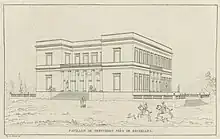
.gif)
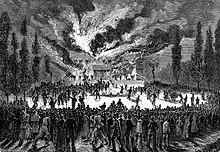
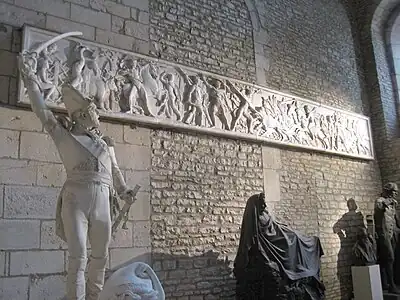
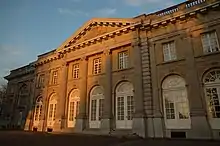
History
William II
In autumn 1815, Prince William II was given control over Tervuren, Belgium.[1][2] As Tervuren Castle was demolished in 1782, a new summer palace was built for his participation at the Battle of Waterloo.[1][2]
It was located in the northwestern edge of the Park of Tervuren.[1][2] The park was expanded to ensure sufficient privacy for the royal family.[1][2] Construction started in 1817 and took five years to complete.[1][2]
The pavilion was lavishly furnished and decorated, including reliefs by François Rude, who was then living in exile in Brussels.[1][2] The building was surrounded by terraces and gardens.[1][2] To the east extended an Italianate garden decorated with neoclassical statues, including Claudius Civilis by the sculptor Jean-Louis Van Geel.[1][2]
Leopold II
After the Belgian Revolution, the Pavilion, together with the entire park of Tervuren, was confiscated by the Belgian state.[1][2] However, most of the furniture was returned to the Dutch royal family.
The pavilion and the surrounding park were given to Leopold I, who then gave it to his heir, Leopold II. Leopold II was very fond of Tervuren and considered living there permanently. Therefore, the park was further expanded.[1][2]
Charlotte of Belgium
After her return to Belgium in the summer of 1867, Charlotte of Belgium, former Empress consort of Mexico and sister of Leopold II, moved into the pavilion for a few months.[1][2] However, the building seemed to be insufficiently furnished and not well adapted to the cold season.[1][2] On 8 October 1867, Charlotte moved in with her brother and sister-in-law in the Palace of Laeken. She did not return to the pavilion until May 1869. On the night of 2 March 1879, a fire broke out in the pavilion.[1] Empress Charlotte was woken up by her ladies-in-waiting and escaped the burning building which was destroyed in the fire. She then moved to Bouchout Castle, where she stayed until her death in 1927.[1]
Afterwards
The pavilion was not rebuilt and Tervuren park remained empty until 1897. At the request of Leopold II, the 1897 Brussels International Exposition took place simultaneously in Brussels and Tervuren.[1][2] Here, the Congo Free State's prosperity was brought to the public's attention.[1][2] To make the colonial exhibition attractive and accessible, Tervuren was connected to the capital with a wide, 12-kilometre tree-lined avenue, flanked by a tram line that was constructed for the occasion.[1][2] At the end of this avenue, on the site of the burnt-down pavilion, the Palace of Colonies was built, designed by Ernest Acker (1852-1912).[1][2] The pavilion was intended as an exhibition space and was framed by classical French gardens with ponds, staircases and statues designed by Elie Lainé.[1][2] Lainé became well known in the 1870s as the designer of the garden at Waddesdon Manor, commissioned by Ferdinand de Rothschild.[1][2] He was exponent to the growing interest in Le Nôtre-styled gardens, which would see a revival mainly due to Henri and Achille Duchêne.[1][2]
Royal Museum for Central Africa
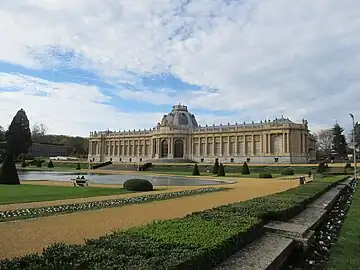
Due to its success, the Palace of Colonies has been a museum since 1898.[1][2] However, the available space was insufficient, so Leopold II decided on 3 December 1902 to expand it so Chinese and Japanese exhibitions could be shown.[1][2] The project was completed by the Congo Free State.[1][2] The French architect Charles Girault (1851-1932), whose Petit Palais was liked by Leopold II at the 1900 Paris World Exhibition, was commissioned to develop a concept that encompassed the entire Lokkaartsveld along the Leuvensesteenweg, including of the Palace of Colonies site.[1][2] In addition to a museum, the project would have also built an international conference center and a school.[1][2] Following the death of Leopold II, only the Congo Museum (1904-1909), the current Royal Museum for Central Africa, would be realized.[1][2]
References
- Wijnants, Maurits (1997). Van hertogen en Kongolezen. Tervuren en de Koloniale tentoonstelling 1897 (in Dutch). Tervuren: Koninklijk museum voor Midden-Afrika. p. 184. ISBN 90-75894090.
- "The Warande in Tervuren". www.onroerenderfgoed.be (in Dutch). Retrieved 6 May 2023.
Further reading
- Davidts, Juul Egied (1981). Het Hertogenkasteel en de Warande van Tervuren (in Dutch). Tervuren: Gemeentebestuur Tervuren.
- Wijnants, Maurits (1997). Van hertogen en Kongolezen. Tervuren en de Koloniale tentoonstelling 1897 (in Dutch). Tervuren: Koninklijk museum voor Midden-Afrika. p. 184. ISBN 90-75894090.